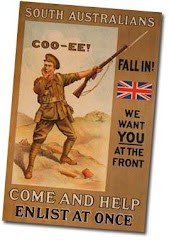
Russell Harris was one of three sons of Charles Hope Harris and Margaret Harris. He was born in North Kensington, SA in 1889. His father was a notable surveyor responsible for surveying large areas of northern South Australia, including the towns of Port Pirie, Laura, Curramulka and Ardrossan.
Russell attended Prince Alfred College, The School of Mines and Industries, and graduated with a Diploma of Commerce from the University of Adelaide in 1912. He was working as an accountant when he enlisted on 13 December 1915.
Russell attended the 3rd Officers' Training School at Duntroon between March and September 1916, and was commissioned as a Second Lieutenant on 1 October 1916. At some point between his initial enlistment and his departure for England, he married Helen Alison Frances Harris and they had a home at Blackwood, where his mother lived. He disembarked in England on 27 March 1917 and after some additional training, was taken on strength of the 27th Battalion in France on 27 June 1917. He was promoted to Lieutenant on 7 September 1917 and was wounded in action during the Battle of Menin Road on 20 September 1917, sustaining a shrapnel wound to his left hand. He displayed leadership and example by continuing to lead his platoon for over five hours, despite great pain. He had to be ordered to leave the frontline to get medical treatment by his company commander after the objective was captured.
Russell recovered to rejoin his unit on 23 October 1917 and received word that he had been mentioned in dispatches for gallant service and devotion to duty for his actions during the Battle of Menin Road. He remained with the battalion until April 1918 when he did a stint at the Corps reinforcement camp as an instructor. He returned to the 27th Battalion in early August 1918, and within a week was wounded for a second time during the Battle of Amiens, this time a gunshot wound to the left leg.
Following the armistice, Russell was granted leave with pay to attend a special AIF course at Bradford Technical College, then worked at Laycock and Sons Wool Mills for education purposes. He resigned his permanent commission on 27 July 1919, and planned to return to Australia via the United States, for business reasons. His wife Helen had been living in London, and accompanied him to the United States.
Russell attended Prince Alfred College, The School of Mines and Industries, and graduated with a Diploma of Commerce from the University of Adelaide in 1912. He was working as an accountant when he enlisted on 13 December 1915.
Russell attended the 3rd Officers' Training School at Duntroon between March and September 1916, and was commissioned as a Second Lieutenant on 1 October 1916. At some point between his initial enlistment and his departure for England, he married Helen Alison Frances Harris and they had a home at Blackwood, where his mother lived. He disembarked in England on 27 March 1917 and after some additional training, was taken on strength of the 27th Battalion in France on 27 June 1917. He was promoted to Lieutenant on 7 September 1917 and was wounded in action during the Battle of Menin Road on 20 September 1917, sustaining a shrapnel wound to his left hand. He displayed leadership and example by continuing to lead his platoon for over five hours, despite great pain. He had to be ordered to leave the frontline to get medical treatment by his company commander after the objective was captured.
Russell recovered to rejoin his unit on 23 October 1917 and received word that he had been mentioned in dispatches for gallant service and devotion to duty for his actions during the Battle of Menin Road. He remained with the battalion until April 1918 when he did a stint at the Corps reinforcement camp as an instructor. He returned to the 27th Battalion in early August 1918, and within a week was wounded for a second time during the Battle of Amiens, this time a gunshot wound to the left leg.
Following the armistice, Russell was granted leave with pay to attend a special AIF course at Bradford Technical College, then worked at Laycock and Sons Wool Mills for education purposes. He resigned his permanent commission on 27 July 1919, and planned to return to Australia via the United States, for business reasons. His wife Helen had been living in London, and accompanied him to the United States.
His younger brother Charles served with the 10th Battalion and survived the war.
Russell subsequently became a citizen of the United States and worked as a wool buyer for American Woolen Mills in Boston for over 34 years. His wife had died prior to 1951 when he visited his daughter, Mrs John Lindon who lived in Fitzroy, SA with her husband Dr John Lindon. He visited Adelaide again in 1954 after his retirement when Dr and Mrs Lindon were living in Aldgate.
His name is inscribed on the Blackwood Memorial.







My great grandfather!
ReplyDeleteI hope you enjoyed reading his story. I'd be interested in details of his later life in the US if someone in the family could provide it. You can contact me at blackwoodsoldiersprojectathotmaildotcom (just put in the right symbols for at and dot!
ReplyDeleteRegards,
Ian